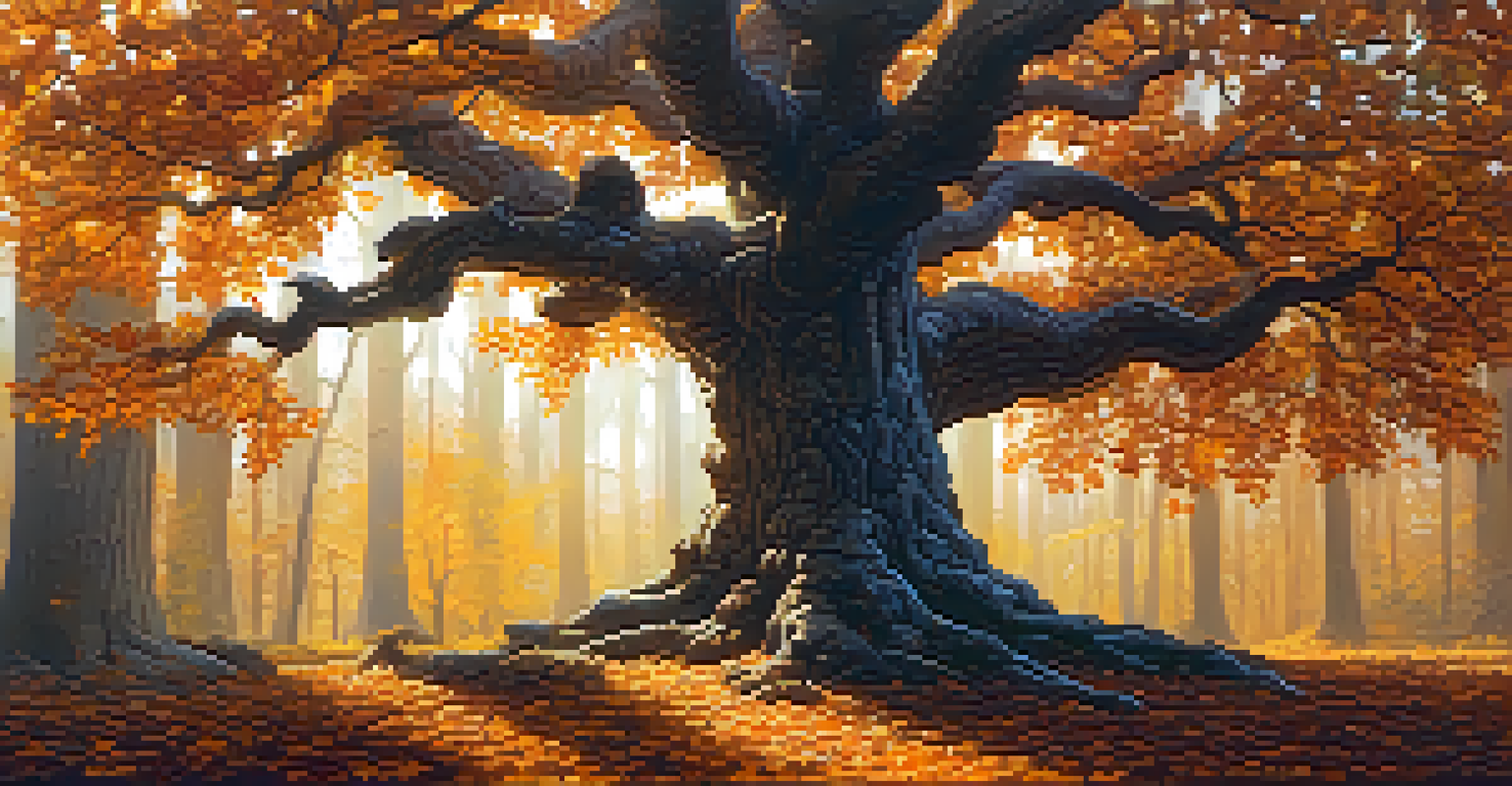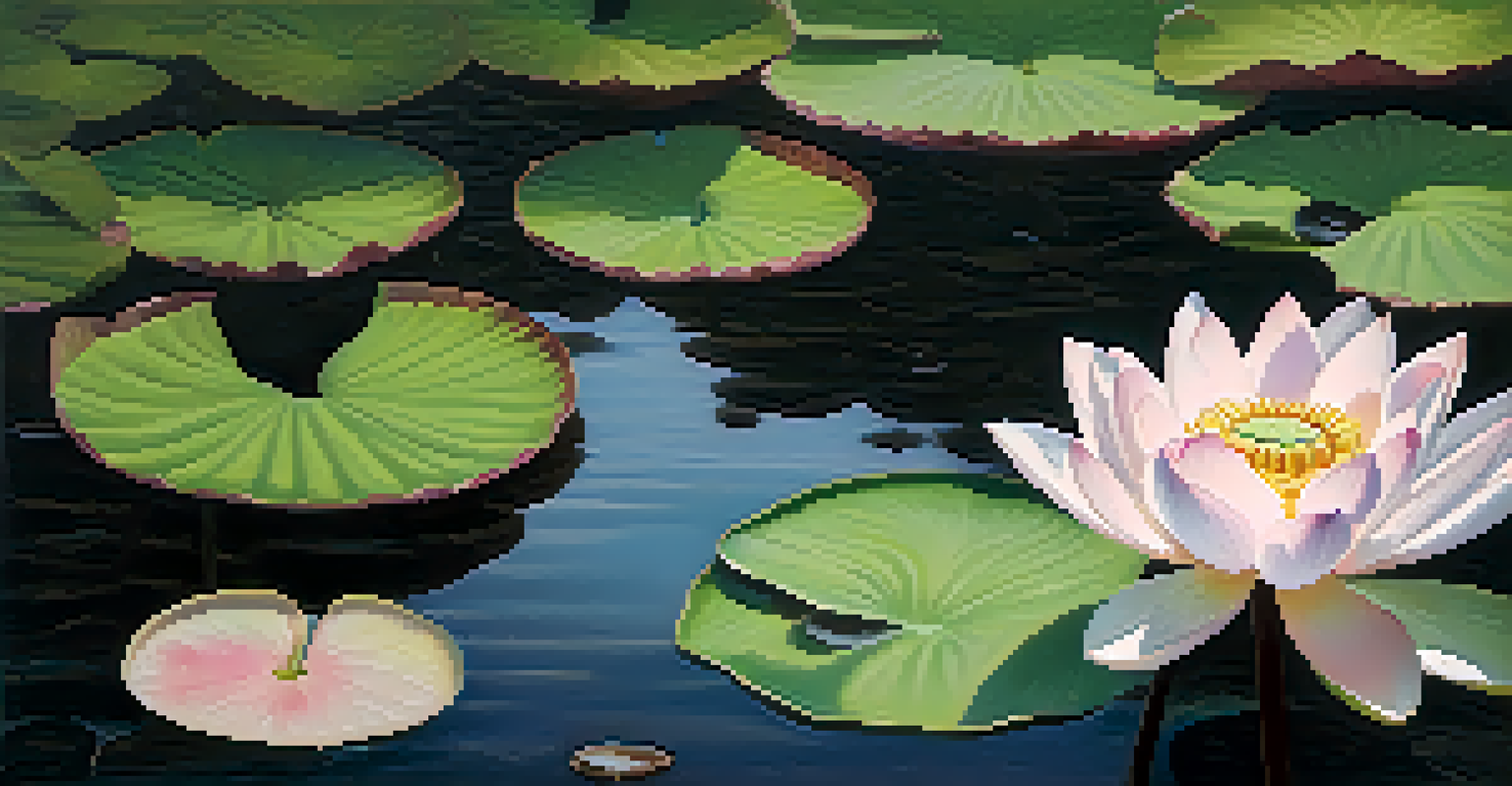The Symbolism of Nature in Art: A Cross-Cultural Analysis

Understanding Symbolism in Nature Across Cultures
Symbolism in art serves as a powerful tool for expressing complex ideas, and nature often plays a central role. Cultures around the world have used natural elements to convey messages, emotions, and spiritual beliefs. For instance, in many Indigenous cultures, animals are seen as totems representing ancestral spirits or guiding forces. This connection between nature and symbolism illustrates how art transcends the boundaries of language and culture.
Nature is not a place to visit. It is home.
Nature's symbolism can vary significantly from one culture to another, reflecting unique histories and philosophies. In Eastern traditions, for example, the cherry blossom symbolizes the fleeting nature of life, highlighting the beauty in transience. Conversely, in Western art, the oak tree might symbolize strength and endurance, showcasing nature's resilience. These differing perspectives enrich our understanding of how cultures interpret the world around them.
Ultimately, recognizing the diverse ways nature is symbolized in art encourages us to appreciate the depth of human expression. It invites viewers to explore the interconnectedness of art and nature, urging them to reflect on their own experiences and beliefs. This journey through symbolism helps foster a greater appreciation for the nuances that exist within various artistic traditions.
Nature in Ancient Art: A Foundation of Symbolism
Ancient art forms often drew heavily on nature, with artists interpreting it through symbolic lenses. From the cave paintings of prehistoric communities to the intricate carvings of ancient Egypt, nature served as both inspiration and subject matter. For example, the Egyptians revered the Nile River, which was depicted in their art as a symbol of life and fertility, essential to their civilization's survival.

In ancient Greece, nature was personified in the form of deities, such as Demeter, the goddess of the harvest. These representations highlighted the significance of agriculture and the changing seasons in daily life. Similarly, the Greeks used symbols like laurel wreaths to represent victory, intertwining nature with celebration and achievement.
Nature Symbolism Across Cultures
Different cultures interpret natural elements in unique ways, reflecting their histories and philosophies.
This use of natural symbolism laid a foundation for future artistic movements, influencing how nature would be interpreted in subsequent eras. By examining these ancient examples, we can see the enduring importance of nature in human creativity and expression, setting the stage for a rich tapestry of artistic symbolism throughout history.
Nature as a Reflection of Spirituality in Art
Many cultures have linked nature with spirituality, using natural elements to symbolize sacred concepts. In Buddhist art, for instance, the lotus flower represents purity and enlightenment, emerging beautifully from muddy waters. This powerful imagery conveys the idea that spiritual growth often comes from overcoming challenges in life.
Art is the most beautiful of all lies; it is nature's truth.
Similarly, in Native American art, the eagle is often depicted as a spiritual messenger, embodying strength and freedom. The deep reverence for nature in these cultures illustrates how art can serve as a bridge between the physical and spiritual realms. Artists use nature to express beliefs and to connect with the divine, creating works that resonate on a profound level.
By exploring these spiritual associations with nature, we gain insight into how art can provide comfort, guidance, and a sense of belonging. This intersection of nature and spirituality emphasizes the importance of understanding cultural contexts when interpreting artistic symbolism, enriching our overall appreciation of the art form.
The Role of Nature in Romanticism and Impressionism
The Romantic and Impressionist movements of the 19th century marked a shift in how nature was portrayed in art, moving towards more personal and emotional interpretations. Romantic artists, like Caspar Friedrich, used landscapes to evoke feelings of awe and introspection, inviting viewers to contemplate their place in the universe. The wild, untamed nature portrayed in their works often symbolizes the sublime, reflecting the power and beauty of the natural world.
Impressionists, on the other hand, focused on capturing the fleeting moments of nature, using light and color to convey atmosphere. Artists like Claude Monet painted scenes of blooming gardens and tranquil water lilies, symbolizing serenity and the passage of time. This emphasis on the ephemeral showcases how nature can evoke a range of emotions, from joy to melancholy.
Spiritual Connections in Art
Many cultures use nature to symbolize sacred concepts, illustrating the link between the physical and spiritual realms.
Both movements highlight the evolving relationship between humanity and nature, suggesting that our experiences shape our artistic expressions. By examining the ways nature is portrayed in these periods, we gain a deeper understanding of how it influences emotions and artistic creativity.
Nature in Contemporary Art: New Perspectives
Contemporary artists continue to explore the symbolism of nature, often addressing pressing environmental issues and personal experiences. Artists like Olafur Eliasson create immersive installations that encourage viewers to reflect on their relationship with the natural world. Through these works, nature becomes a catalyst for dialogue about climate change and sustainability, symbolizing both beauty and urgency.
Additionally, many contemporary artists draw from their cultural backgrounds to reinterpret natural symbols in innovative ways. For example, artists may integrate traditional motifs with modern techniques, creating a fusion of old and new that resonates across cultures. This blending of styles not only honors cultural heritage but also invites broader conversations about identity and belonging.
By examining contemporary perspectives on nature, we see how art serves as a powerful medium for social commentary and change. This ongoing dialogue between nature and art reflects our evolving understanding of the world, encouraging us to engage with and protect the environment in meaningful ways.
Cultural Differences in Nature Symbolism in Art
Cultural backgrounds significantly influence how nature is symbolized in art, leading to rich and varied interpretations. For instance, in Japanese art, the use of seasonal imagery, such as cherry blossoms in spring or maple leaves in autumn, reflects the beauty of impermanence. These symbols remind viewers to appreciate the transient moments in life, a concept deeply embedded in Japanese aesthetics.
In contrast, African art often utilizes vibrant colors and patterns to celebrate the connection between nature and community. The use of animal motifs, such as lions or elephants, embodies power and resilience, while also representing cultural values and stories. This interplay between nature and cultural identity fosters a sense of belonging and continuity across generations.
Evolving Perspectives on Nature
Contemporary artists explore nature's symbolism to address environmental issues and personal experiences, fostering dialogue and change.
Understanding these cultural differences enriches our appreciation for the diverse ways nature is represented in art. It encourages us to consider how our own experiences shape our interpretations, fostering empathy and openness to the richness of global artistic expressions.
The Future of Nature Symbolism in Art
As we move forward, the symbolism of nature in art is likely to evolve alongside societal changes and technological advancements. Artists may increasingly incorporate digital mediums and interactive experiences to engage audiences in new ways. For example, virtual reality installations can immerse viewers in natural environments, prompting reflections on environmental stewardship and personal responsibility.
Moreover, as global awareness of climate change grows, art will continue to serve as a platform for advocacy and education. Artists are using their work to raise awareness about ecological issues, transforming nature into a symbol of both fragility and resilience. This duality encourages viewers to reconsider their own impact on the environment and to foster a deeper connection with the natural world.

Ultimately, the future of nature symbolism in art holds endless possibilities for creativity and expression. By embracing innovative approaches and addressing contemporary challenges, artists can inspire meaningful conversations about our relationship with nature, ensuring that its symbolism remains relevant in an ever-changing world.